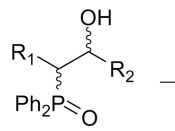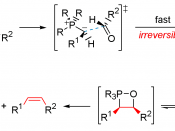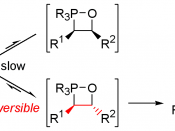INTRODUCTION
The purpose of this experiment is to synthesize trans-9-(2-phenylethenyl) anthracene from benzyltriphenylphosphonium chloride and 9-anthraldehyde through the reaction mechanism recognized as the Wittig Reaction. The Wittig Reaction allows the chemist to synthesize phosphoranes in the lab with relative ease. A more recent and inexpensive version of the reaction is the Wittig-Horner reaction (1).
ABSTRACT
Georg Wittig was a German chemist and Nobel Prize winner in 1979 for the Wittig reaction (1). He was born in Berlin, on June 16, 1897, and died August 26, 1987 (1). Wittig discovered the route to alkenes through ylide molecules (1). Wittig was educated originally at Tubingen; Wittig spent periods at Braunschweig, Freigurg, back to Tubingen again before taking up the post as director of the organic chemistry department at Heidelberg (1). Wittig became an emeritus professor in 1967, where he remained until the end of his notable career (1). In 1967, he won the Otto Hahn Prize, and in 1979, he and Herbert C.
Brown were jointly awarded the Nobel Prize for their development of the use of boron and phosphorus-containing compounds for important reagents in organic synthesis (1).
The foundation of the Wittig reaction is not complex. Phosphorus is a second row element - in-group 5 - like nitrogen, but unlike nitrogen, has the ability to expand its valencey from 3 to 4, 5, or even 6 (1). The stable 5 valencies are met in compounds like phosphoric acid and PCL (1). Wittig discovered that phosphines, which are the phosphorus equivalent of amines, easily form phosphonium salts with alkyl halides and that these salts readily lose HX with strong base. This product is called an ylide or a phosphorane. The ylide is a polar molecule with a carbanionic carbon.
Figure 1. How to make a phosphorus ylid (1)
In relation to stereochemistry,


